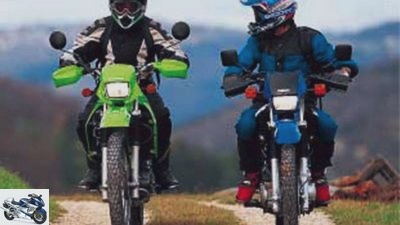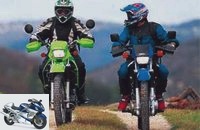Menus

Comparison test Kawasaki KLR 650 / Yamaha XT 600 E.
Simple and poignant
The XT 600 E brings back wistful memories of the great days of single-cylinder enduro bikes: undemanding, robust, versatile. This is also the recipe for the Kawasaki KLR 650. MOTORRAD tested the last of its kind.
Specialization is the order of the day. This applies to professional life as well as to motorcycles: There are special machines for every purpose, whether off-road, long tours, short distances or racing slopes. Even such a narrow segment as the enduro sector has split up into sports and hard enduros, travel enduros, funduros, fun bikes, super motos and so on. The classic all-round enduro, so to speak the egg-laying woolly milk pig, has unchanged its qualities, which were highly valued in previous years.
The single-cylinder Enduros experienced their heyday in the eighties, XTs, XLs, DRs and KLRs sold en masse. Yamaha has sold more than 35,000 machines in the XT 600 series since its debut in 1983, and around 25,000 are still in service. People went and go with them on trips, off-road, fetching bread, going on desert tours or circling the globe. In principle, the XT 600 E and KLR 650 have not lost any of their capabilities. But progress relativizes the standstill pretty quickly. Because technically, the current XT differs little from the first 600 series from 1983. Over the years, the XT, which was still quite sporty in its beginnings, has become a brave, staid everyday machine. The spring travel was cut, the aluminum swingarm had to give way to a steel part, the same applies to the rims, even the luggage rack fell victim to the red pencil at some point.
The Kawasaki KLR 650 has been built in its current form since 1995, but it is also a real oldie. The engine concept comes from the KLR 600, in 1985 it was technically fully up to date with water cooling, four valves, two camshafts and two balancer shafts. However, the image suffered from the initial engine damage. From the second model year onwards, the electric starter hardly helped either. An increase in displacement made the KLR the 650 in 1987. For the time being, the last evolutionary stage, the Tengai, came to an end in 1992, replaced by the more modern KLX 650. This was only granted a short, glorious life, surprisingly in 1995 the Japanese conjured up the good old KLR in a revised form.
In terms of performance, both oldies have seen better days. Because the short-geared single cylinders have to pay tribute to the more stringent regulations for noise measurement. Which – by the way – is unfair anyway, as the slow, small machines reach much higher speeds than the long-geared big bikes. The Kawa singles managed up to 48 hp in their heyday, so the current KLR looks comparatively old with 42 hp. The Yamaha was also in better shape once before, the constricted, air-cooled stew only presses 39 hp on the role.
Nobody expects such a motorized antiquarian bookshop to deliver rapid performance. After all, the Kawa gives the impression that she is doing her best. It marches bravely from below, if necessary turns without grumbling in the upper area, if you give it the spurs. So it conveys at least a tiny touch of sportiness. But to avoid misunderstandings: The KLR is miles away from a KTM LC4 or a BMW F 650. This is even more true of the XT. Although it starts from around 2000 revolutions without jerking and chain whipping, the powerful single-cylinder blow fizzles out in the constricted airways. The XT just looks tired and slack in all speed ranges. There is only one recipe: keep calm, let your colleagues go and chug through the landscape at a leisurely pace. Once you’ve discovered slowness, you won’t get upset about the phlegmatic nature of the XT. Then the consumption is kept within limits, while the XT requires a proper surcharge at full throttle.
The fact that Yamaha has made undemanding a principle is made clear by its chassis. The egg dance starts at 120 km / h, at top speed there is hardly any question of stable straight-line stability. Which may be a bit uncomfortable or takes getting used to, but by no means dangerous. Because the XT never rocks, it just doesn’t want to go straight on in a stable manner. The Kawa manages this surprisingly well, given the Enduro tires. Even if it is squeezed inappropriately on the motorway, there are practically no pendulums at all.
The differences are all the more astonishing as the Kawa is much softer, while the XT is taut. However, the spring elements do not seem really balanced in either case. Despite the soft design, the Kawa is not exactly comfortable, with coarser bumps or deep manhole covers the suspension elements come into the progressive area early, so that there are quite hard hits in the handlebars. With the XT, it is more a matter of sensitivity.
One-cylinder machines are the handiest cornering speedsters, according to general belief. The two enduros provide counter-evidence. First, because at higher speeds they become quite immobile due to the gyroscopic forces of the large and heavy front wheel rims. Noticeably noticeable when folding over in alternating bends, you have to pull hard on the wide handlebars, they just stubbornly follow the steering impulses. Secondly, because at any speed they flutter through bends with no orientation, a series of twist-prone forks, lax chassis and simple enduro tires. Only with concentration and experience can curve combinations be mastered on the desired optimal line. In principle, this applies to both, but the Kawa is a little more precise, more light-footed. The XT is always imprecise in the steering, a stiffer fork would be helpful.
The torsion-friendly front suspension is also noticeable when braking, with the front wheel and handlebar twisting clearly noticeably against each other. And that, although the Yamaha does not exactly delay vehemently and requires high manual strength. However, what bothers the most is the poor controllability, and a feeling for the slip limit is hardly conveyed. The KLR brakes a little better. Your biggest drawback: When you brake hard, the front wheel sometimes starts jumping wildly.
Hdoesn’t seem particularly tingly. Virtues like reliability, robustness and unpretentiousness are out. In any case, the two enduro oldies will no longer win a flower pot against the modern specialists. Who is content nowadays with an egg-laying woolly milk sow that lays small eggs, gives little wool and milk and has hardly any meat on its ribs??
Buy complete article

Comparison test Kawasaki KLR 650 / Yamaha XT 600 E.
Simple and poignant
1st place: Kawasaki KLR 650
Hooray, a victory for the elderly KLR. But on closer inspection it is more likely a Pyrrhic victory, because against a reasonably strong opponent, the Kawa would also look old. The result of 491 points makes the distance to more modern designs such as a BMW F 650 GS (632 points) all too clear. In terms of properties, the KLR is clearly ahead of the XT thanks to the more agile engine and better chassis, but due to the high consumption and inspection costs, it is still tight in the end.
2nd place: Yamaha XT 600 E.
At the end of its twenty-year career, the good old XT almost landed an unexpected success against an equally aged opponent. If the chassis weren’t so sloppy, the engine wasn’t so smooth, the front brake was bite or the pillion passenger had more space. So the classic XT virtues remain as plus points: moderate highway consumption, low costs and a robust drive. An oldie for the undemanding.
Related articles
-
fact Comparison test Crosser In limbo It seems clear that the four-stroke crossers in the small class will soon take over the helm. But now? Have a look…
-
2017 super sports car in the country road comparison test
fact 28 photos factstudio.de 1/28 The 2017 superbikes were just battling it out on the racetrack, now the focus is on the country road, everyday…
-
Comparison test of the 650 all-rounder
Weihs Comparison test of the 650 all-rounder He and her and 1000 questions As a hot new addition, the Kawasaki ER-6n enriches the bare middle class….
-
Comparison test of the 600 super sports car
Comparison test of the 600 super sports car It’s getting tight Riot in the sports group. A whopping 124 hp, a ridiculous 207 kilograms with a full tank,…
-
Comparison test of enduro bikes
Comparison test enduros Last groove How much leisure time can you have with everyday enduros like the XT 600 E, the KLR 650 or the new DR 650 SE? On firm…
-
Comparison test of sporty enduros
Comparison test, KTM 620 LC 4, Suzuki DR 650 SE, Triumph TT 600 Sporty Enduros Too good for tough sport use and too rough for everyday life: KTM 620 LC4 …
-
Yamaha Tracer 700 and Kawasaki Ninja 650 in comparison test
Arturo Rivas Yamaha Tracer 700 and Kawasaki Ninja 650 in the comparison test of mid-range sports tourers Some like it upright, others more …
-
Comparison test Honda VT 750 C2-Kawasaki VN 800 Classic
Comparison test Honda VT 750 C2 / Kawasaki VN 800 Classic End of the line longing Or how you can also get your kicks in Stuttgart-Bad Cannstatt. Caught….
-
Comparison test of 400 sports enduros
Comparison test of 400 sports enduros Master hunter With the 400 EXC, KTM took the Enduro World Championship title last year. The Euro-Fighter for 2000…
-
PS Bridgestone Tuner GP 2016 – 1000 Superbikes in comparison test
fact 27 photos markus-jahn.com 1/27 Picture gallery, TunerGP: 1000 Superbikes in comparison. markus-jahn.com 2/27 Bartschat-Kawasaki ZX-10R. Lap time:…